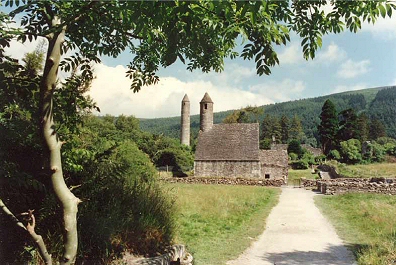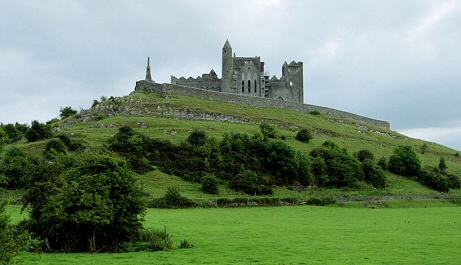

Glendalough (Gleann Dá Locha in Irish, meaning "the glen of two lakes") is a village located at the site of an ancient monastery in County Wicklow, Ireland. It was founded in the 6th century by St. Kevin, a hermit priest, and destroyed in 1398 by English troops. The location was chosen by St. Kevin because of its remoteness, but several disciples who wished to follow his teachings built a temporary hamlet of churches, chapels and living quarters in the valley below the site of his hovel. This soon grew and eventually, at the height of its popularity, was one of the main religious universities in Ireland. The name Glendalough comes from the Irish Gleann Dá Locha meaning the glen (valley) of two lakes. The monastery site is located between two lakes (Lower Lake and Upper Lake) and is one of the most popular tourist sites in Wicklow. The monastic site includes a 33 metres tall round tower and St. Kevin's Cross, a Celtic High cross. The round tower was built during the era of the viking invasions in Ireland (up to and around AD1066), in order to protect the religious relics, books and chalices used around the monastery at the time.
The Rock of Cashel is located at
Cashel,
County Tipperary, in southern Ireland. The complex has a unique and native
character of its own. It is one of the most remarkable collections of
Celtic art
and
medieval architecture to be found anywhere in Europe. The earliest
building of Cashel is the
round
tower, a perfectly preserved 28 metre (90 feet) tower, which dates from c.1100.
The Chapel of King Cormac (1134)
is the most important building from the point of view of the modern visitor.
Begun in 1127, it
is a very sophisticated structure, unlike most Irish
Romanesque
churches which are simple in plan with isolated decorated features. The
Cathedral, built between
1235 and
1270, is an
aisle-less building of
cruciform
plan, having a central tower and terminating westwards in a massive residential
castle. In 1647,
during the
Irish Confederate Wars, Cashel was sacked by English Parliamentarian troops
under
Murrough O'Brien, Earl of Inchiquinn. The Irish Confederate troops were
massacred, as were the Roman Catholic clergy. Inchiquinn's troops also looted or
destroyed many important religious artifacts.
Monasteries at Glendalough and Cashel, Ireland


Christian monasticism started in Egypt. According to
tradition, in the third century St. Anthony was the first Christian to adopt
this lifestyle. The life of prayer and communal living was one of rigorous
schedules and self sacrifice. Prayers took up much of a monk's waking
hours. In between prayers, monks were allowed to sit in the
cloister and work on their projects of writing,
copying, or decorating books. The main meal of the day took place around noon,
and consisted of the most simple and bland foods. While they ate, scripture
would be read from a pulpit above them. Since no other words were allowed to be
spoken, monks developed communicative gestures.
Abbots and notable guests were honored with a
seat at the high table, while everyone else sat perpendicular to that in the
order of seniority. This practice remained when monasteries became universities
after the first millennium, and can still be seen at Oxford and Cambridge.
Monasteries were important contributors to the surrounding community. During the
plagues, monks helped to till the fields and provide food for the sick.
Monasteries were centers of intellectual progression and education. They
welcomed apsiring priests to come study and learn, allowing them even to
challenge doctrine in dialogue with superiors.
|
hermit |
remete |
|
abbot |
apát, rendházfőnök |
|
cloister |
zárka, klastrom |
credits:
1. The text was extracted from Wikipedia The Free Encyclopedia under GNU Free Documentation Licence.